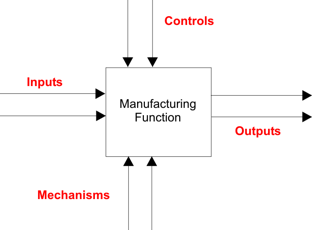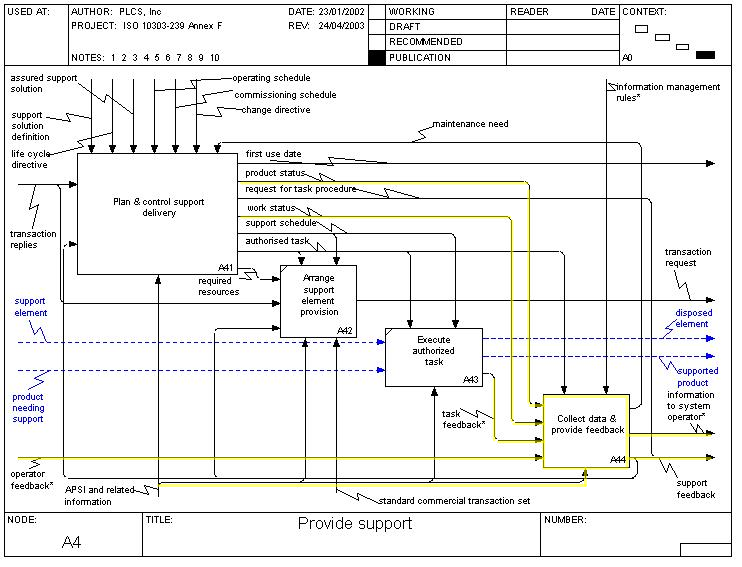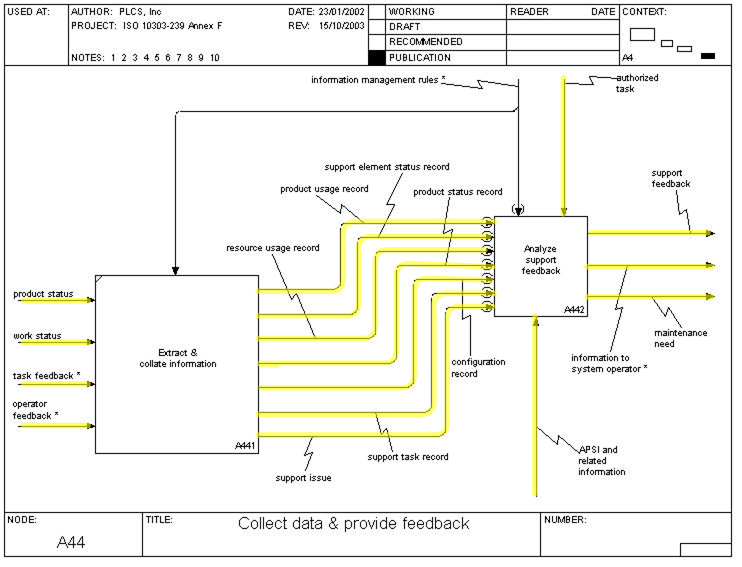
| Business DEX:— MoDAvDEX | Date: 2008/03/13 22:27:37 Revision: 1.7 |
The ISO 10303-239 PLCS Application Activity Model (AAM) is an IDEF0 representation of the business activities that set the scope and information requirements for the PLCS standard. The model is composed of a set of figures and a set of definitions of these business activities and their associated information flows.
IDEFØ provides a graphical notation for function modeling of an organization or system. Activities can be described by their inputs, outputs, controls and mechanisms (ICOMs).

This DEX supports a subset of these business activities and information flows. These are highlighted in yellow in the figures Figure 1 and Figure 2.
The information flows marked with an asterisk are not explicitly represented within PLCS. This information is instead transferred by other means, e.g., handled by a document.


The activity labels in the AAM views above have the following definitions:
analysis of support feedback from individual tasks to determine exceptions from the support solution, exceptional maintenance needs, the impact on operations, and suggestions for improvement
action to collect and capture into the information technology infrastructure the data generated by support activities or by use of the product
NOTE
Feedback includes:
action to extract and collate information from operation and support activities into a form that complies with the information management rules
The ICOM arrow labels in the AAM views above have the following definitions:
set of information, subject to configuration change management, that is established to develop and deliver support for a product in focus
NOTE
This term corresponds to the EIA 649 term "product configuration information" which includes:
set of assured and related information used to develop and deliver support for a product in focus, including feedback from using and supporting the product over its life cycle
NOTE Related information includes records of the history of the usage or support of realized products, design and support analysis results and reasons why decisions were taken. Such information includes design and failure analysis records, logistic support analyses, running hours, environment descriptions, operating profiles; test results, records of maintenance activities, resources used, and faults found plus any other content deemed relevant to life cycle support.
record of the configuration of a realized product
NOTE Records of configuration status may be required following incorporation of a configuration change, the removal of a serialized item, the replacement of a serialized item or the performance of a configuration audit task.
information provided to the user or operator of a product needing support regarding the condition of the supported product
NOTE
Such information can include:
information provided to support authorities by operators including information on product health and usage, and equipment problems discovered by operators
NOTE Such feedback can include trouble reports, log books and other data from on-board recording systems, passed to support authorities for analysis. The operator feedback is structured to conform to the information management rules by activity A4.4 and is communicated within this model by the support feedback arrow.
notification of the current state of a product receiving support, as confirmed by the authority controlling the work
observations, measured characteristics or a record of the state of a product needing support
NOTE The state of a product can include the existence of fault, an operational state or a status in relation to recognized steps or stages of a support process such as awaiting test or ready for dispatch.
information of the past use of an operational product
NOTE Product use can be quantified against any usage parameter in any pre-defined operational or usage state such as product life, number of landings or hours spent above 50% power. Product use records can be contained in, or extracted from, log books or electronic records, such as tapes or discs, as provided by product operators or other personnel.
information on the past use of a resource in the course of performing one or more support tasks
NOTE Resource usage includes the consumption of spares or consumables, time spent by human resources in performing support tasks and the usage of support locations or facilities. Usage may also be measured by other parameters such as elapsed time, number of starts or cycles of operation.
observations on the condition, measured property or status of a support element that has been, or is being used, as a resource for a task
NOTE
Possible states of a support element include:
observation on the condition or usage of a product receiving support and on the execution of support activities
NOTE
Support feedback is generated when tasks are performed on a product needing support. It includes information on:
request for action to resolve, or an expression of concern about, a problem arising from working on a product needing support
NOTE This may include requests to modify the product or support solution definition.
information on the state of a current or completed activity, including reports of completion of individual task steps
information, in any form, derived from observation of a realized activity including progress, findings or resource use, prior to the capture of this information in the format required by the information management rules
information on the progress of activities in relation to a support schedule
NOTE This information on status is transient and will change as the work progresses.
© UK MOD 2010 — All rights reserved